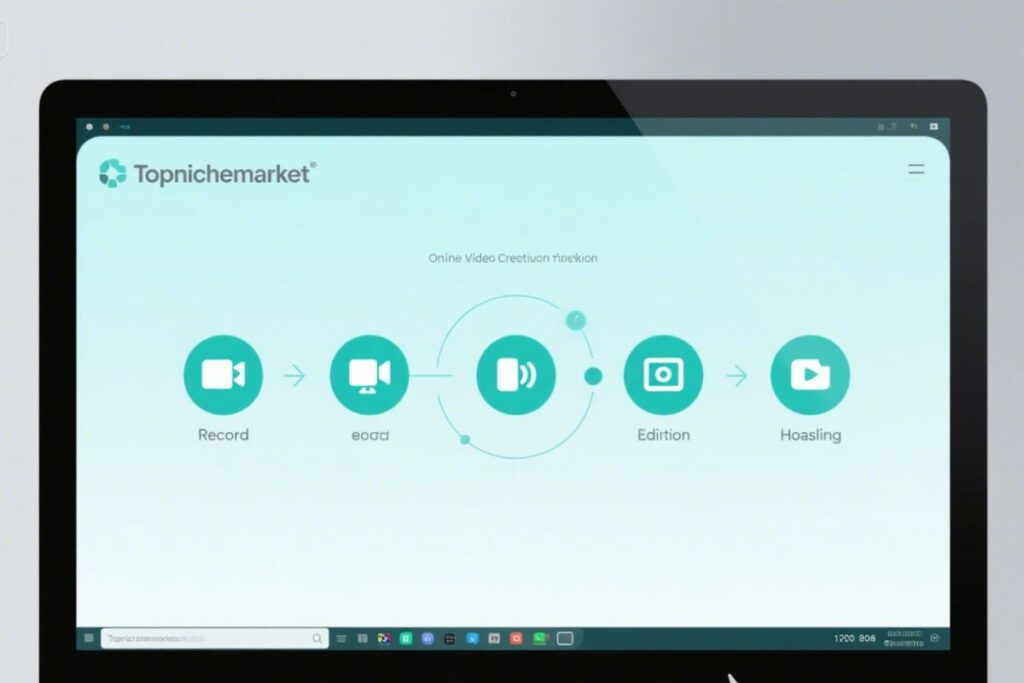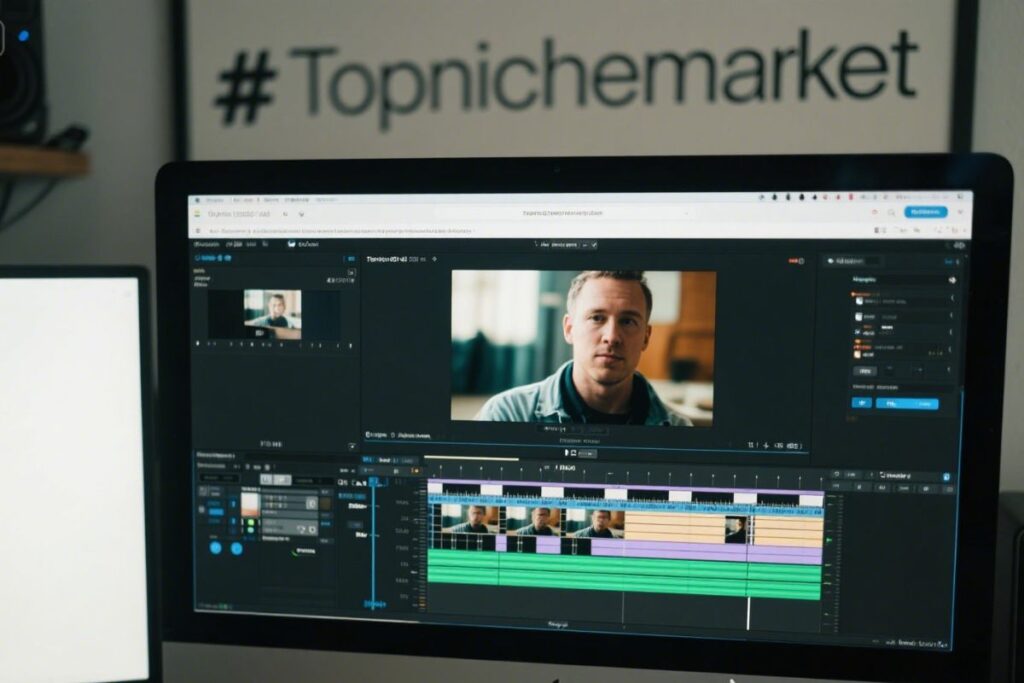Table of Contents
ToggleIntroduction What is Tella and What Do Users Say About This Online Tool?

Introduction What is Tella and What Do Users Say About This Online Tool
Stepping into the arena of online creation tools, Tella presents itself as a contender in the realm of online video editing and serving as a video capture website. The platform positions itself as a means to simplify the complex process of video creation, promising a way to record, edit, and share videos for a variety of user needs. It aims to consolidate steps that might typically require multiple software applications, offering a potentially streamlined workflow. But beyond the platform’s own description and aspirations, what is the tangible, real-world user experience like? To gain an unfiltered perspective on Tella’s performance and usability, we have turned to Trustpilot, a well-known and widely used review platform where users share their firsthand encounters and opinions based on their actual usage of services and products.
Currently, based on the specific data available at the time of this analysis – which consists of a very small number of reviews, specifically four – Tella holds an average rating of 3.3 stars out of a possible 5 on the Trustpilot platform. This rating, while derived from extremely limited feedback, provides an initial glimpse into the level of user satisfaction and the overall sentiment surrounding the platform. An average rating of 3.3 stars is inherently a mixed score; it strongly suggests that while some users have experienced positive outcomes and found value in the service, others have evidently encountered significant issues or aspects of the platform that did not meet their expectations, leading to less favorable reviews. The limited number of reviews makes this average more indicative of potential rather than definitive performance for a large user base.
The explicit purpose and scope of this article are to meticulously analyze and accurately summarize the feedback provided within these four specific Trustpilot reviews. Our aim is to offer an honest and grounded overview of Tella’s perceived strengths and weaknesses, derived not from conducting our own independent testing of the platform or incorporating external research findings from other sources, but strictly and solely from the voices and experiences of these particular users as documented in their Trustpilot submissions. We are building this analysis block by block, using only the material provided by these four individuals.
Throughout the subsequent sections of this analysis, we will systematically cover the key features and functionalities of Tella that users have explicitly praised or found useful. We will also delve into the frustrating issues, technical glitches, and bugs they have reported experiencing during their use of the platform. We will examine their comments and insights regarding the platform’s overall ease of use and the perceived quality of the user experience. Following this, we will compile a concise summary of the pros and cons, meticulously extracted and synthesized from their collective feedback. Finally, we will conclude by attempting to answer a crucial question, based *only* on this available user feedback: Is Tella a recommended tool for individuals or teams looking for solutions in the realm of online video editing and video capture? By maintaining our focus exclusively on these specific user perspectives, we sincerely hope to offer a grounded, albeit limited, look at what it might genuinely be like to use Tella as your go-to tool for fulfilling your online video editing and video capture website needs.
User Feedback on Tella’s Features and Functionality (The “Online Video Redactor” Experience)

User Feedback on Tella’s Features and Functionality (The Online Video Redactor Experience)
Let’s now transition to a detailed examination of the core functionality offered by Tella as described and perceived by those who have directly used it. This section will essentially explore their reported experiences with the platform operating as an online video redactor. What specific aspects of Tella’s features and capabilities stand out in their feedback, both positively and negatively, according to these particular reviews available on Trustpilot?
Based on comments provided by users such as Martin Fitzpatrick and Björn Ingmanson, Tella appears to receive praise from some individuals for being a comprehensive and effective solution that successfully covers the essential and interconnected steps of the video creation process. These steps include the initial recording of video content, the subsequent editing phase, and finally, the hosting or sharing of the finished product. This positive feedback suggests that, for a subset of users, Tella manages to integrate these different stages seamlessly into a single, unified platform. This integrated approach potentially streamlines a user’s workflow significantly, a process that might otherwise necessitate the use of multiple disparate tools and services to achieve the same outcome. Martin Fitzpatrick specifically highlights this integrated approach as a substantial advantage, implying that it meets a real and tangible need for digital creators who are actively seeking an all-in-one solution to simplify their video production pipeline.
The reviews also provide insights into the specific types of videos that are being successfully created and utilized with Tella. Users mention employing the platform for producing ‘talking-head’ videos, which are common for vlogs, messages, or direct address communication. They also reference creating ‘explainer’ videos, which are popular for tutorials, product demonstrations, or concept explanations. Furthermore, Tella is reported as being used for both internal communication purposes within organizations and for external communication needs aimed at broader audiences. This variety of reported uses indicates that Tella possesses potential versatility and is being successfully applied to a range of common video formats and applications. This versatility highlights its potential to cater to different user needs, encompassing everyone from educators and marketers to internal corporate teams requiring efficient video communication tools.
Specific feature functionalities integrated within Tella’s online video redactor capabilities also receive explicit positive mentions. Björn Ingmanson, for instance, expresses appreciation for specific features like zoom and subtitle functionalities. The ability to zoom in on a particular area during screen recordings is a crucial tool, especially valuable for creating detailed tutorials, software walkthroughs, or explainer videos where it’s necessary to direct the viewer’s attention to specific elements on the screen. This feature helps in clarifying complex information and improving viewer comprehension. Subtitle functionalities, increasingly important in today’s digital landscape, play a vital role in enhancing video accessibility for viewers who are deaf or hard of hearing, as well as for expanding the reach of content to audiences who prefer to watch videos without sound or who speak different languages. The positive mention of Tella’s subtitle feature suggests that the platform offers a usable and effective implementation of this capability. These specific praises paint a picture of an online video redactor that thoughtfully includes valuable tools designed to enhance the quality and reach of video content created on the platform.
However, the overall picture is not uniformly positive when evaluating the online video redactor experience based on these reviews. Feedback from user Max Vellucci introduces a crucial counterpoint, highlighting significant negative comments directly related to the actual online editing process itself. Despite having, and explicitly stating they had, a fast internet connection which would typically mitigate performance issues in online tools, Max Vellucci reported experiencing substantial difficulties and problems with the online editing functionality. This critical feedback strongly suggests that while the *presence* and availability of editing features within Tella are acknowledged and potentially appreciated in concept, their *performance*, reliability, or stability within the browser-based environment might represent a significant hurdle and source of frustration for some users. Problems encountered during the online editing process can manifest in numerous ways, including but not limited to slow loading times for footage or projects, noticeable lag or unresponsiveness during editing actions such as cutting, trimming, or adding elements, difficulties in precisely manipulating video or audio elements, or even outright failure of the platform to execute intended editing actions or save changes. For anyone who relies on Tella as their primary online video redactor for regular or professional use, these technical hitches and performance issues can severely impact productivity, disrupt the creative flow, and ultimately compromise the ability to produce desired content efficiently. The fact that these issues were reported even when the user met the apparent requirement of a very fast connection raises serious questions about the fundamental technical stability or optimization of the platform’s editing suite.
Furthermore, while user Martin Fitzpatrick found the audio treatment features acceptable enough to use Tella effectively for their purposes, they also noted that these features could potentially be improved. This comment, though less severe than the reported editing performance issues, points to another specific area where the online video redactor functionality might not fully meet the expectations of all users, particularly those who require more advanced or granular control over the sound elements of their videos. Audio quality is a paramount factor in the overall perception of video professionalism and polish, and limitations in editing capabilities specifically for sound can certainly be a drawback, particularly for users aiming for a high level of production value in their video content.
In summary, based exclusively on the feedback gathered from these few Trustpilot reviews, Tella’s features are perceived by some users as forming a convenient and integrated package for managing the full video creation lifecycle: recording, editing, and hosting. The platform is reported to support various common video types and use cases, and some specific tools within the online video redactor like zoom and subtitles are highlighted positively as valuable additions. However, this positive perspective is balanced by reports of significant and concerning issues directly related to the core online video redactor functionality. Specifically, reports regarding online editing performance problems, which persist even when users have supposedly optimal internet connections, alongside mentions of limitations in areas like audio treatment, present a mixed and complex view of the user experience with Tella’s features. This discrepancy highlights a potential gap between the platform’s intended functionality and the actual, reliable performance experienced by some users, particularly when it comes to the demands of online video editing.
Ease of Use and User Experience Navigating Tella Based on Reviews

Ease of Use and User Experience Navigating Tella Based on Reviews
Moving beyond the evaluation of specific features within the online video editing capabilities, let’s consider how easy and pleasant the overall experience of interacting with and using Tella is, according to the commentary provided within these user reviews. User experience (often abbreviated as UX) is a broad concept that encompasses every interaction a user has with a product or service. In the context of Tella, this includes everything from the initial onboarding and interface simplicity to the frustrations encountered during the creative workflow, managing one’s account, or dealing with customer service (though customer service itself wasn’t detailed in these specific reviews, administrative processes were).
Some users, notably Martin Fitzpatrick, explicitly highlight aspects of Tella’s perceived simplicity and its potential to save considerable time when compared to navigating and using more complex or traditional video editing tools. In today’s crowded digital landscape, which is often saturated with software applications that boast a multitude of features but come with steep learning curves, a tool that genuinely prioritizes ease of use can be incredibly appealing and can address a significant user need. If Tella successfully manages to make the processes of video recording, basic editing, and publishing straightforward and intuitive, it effectively fulfills a key requirement for a large segment of users – those who do not wish to invest significant time in learning complicated interfaces, navigating technical jargon, or overcoming steep operational hurdles. The specific mention of Tella being time-saving suggests that, for these particular users, the platform successfully helps them move from an initial idea or concept to a finished, published video efficiently and without unnecessary delays. This reported ease of use is a significant ‘pro’ or advantage for anyone seeking a hassle-free and quick approach to their video capture website and subsequent editing needs. It suggests that for basic tasks, the barrier to entry might be low.
However, a comprehensive analysis of the reviews also reveals notable challenges directly related to user experience that extend beyond just the successful or unsuccessful implementation of specific features. Max Vellucci’s feedback, which focuses heavily on technical issues, again points to frustrating and persistent problems such as recurring bugs. Experiencing bugs during the creative process, especially within an online video editing environment, is far more than just a minor technical glitch; it represents a direct and significant impediment to a smooth, productive, and enjoyable user experience. Bugs can lead to unpredictable behavior from the software, cause loss of work that has already been invested, introduce errors into the final output, and generate significant levels of user frustration. These issues fundamentally undermine the perceived ease of use and reliability of the platform. The report that these persistent bugs make the platform difficult to use for professional purposes speaks volumes about the negative impact on users who depend on Tella’s stability and reliability to perform their work effectively, whether for clients, employers, or their own business.
The aforementioned requirement for a “very fast connection for editing,” while perhaps technically understandable for a browser-based tool handling large video files, is another significant factor that impacts the overall user experience. This requirement creates a fundamental dependency on external internet infrastructure and can act as a potential barrier to entry or consistent use for users located in areas with less robust or reliable internet connectivity. More crucially, as reported, even meeting this requirement by having a fast connection did not prevent the occurrence of performance problems, suggesting that the issue might stem from deeper within the platform’s architecture or optimization rather than solely residing with the user’s network. Regardless of the root cause, the *existence* of such a stringent requirement, coupled with the report that it doesn’t guarantee a smooth experience, significantly affects the user experience and sets expectations that might not be met.
Perhaps one of the most frustrating and impactful user experience issues reported is the demoralizing necessity to redo work that has already been completed due to technical problems or platform failures. Max Vellucci specifically mentions the deeply frustrating experience of wasting hours of valuable time, directly implying scenarios where significant effort and time invested in recording, editing, or refining video content was lost because the platform did not function correctly or reliably. This is a critically important point for the evaluation of any digital tool, particularly one used for professional or important personal projects. The risk of losing significant amounts of invested work is a major deterrent for potential users and constitutes a severe blow to the perceived user experience and trust in the platform. It directly contradicts any praise regarding the platform being time-saving or simple, as losing hours of work is the antithesis of efficiency.
Furthermore, feedback contributed by Mauro Benedetto introduces a different, but equally significant, dimension of the overall user experience: the administrative side of the platform, specifically concerning the account cancellation process. Mauro Benedetto describes their experience with attempting to cancel their subscription as difficult and notably lacking in transparency. User experience is not limited solely to the interaction with the core functionality of the online video redactor; it also crucially involves the administrative ease and clarity of managing one’s subscription and account details. A difficult, confusing, or opaque cancellation process can leave users feeling trapped, frustrated, and ultimately erode trust in the service provider. This issue, while seemingly unrelated to the technical capabilities of the online video editing features themselves, is a critical part of the overall user journey and can significantly sour how a user perceives not only the platform but also the company operating it. It directly addresses a fundamental user need for control, clear communication, and straightforward policies regarding their contractual relationship with the service.
In essence, while Tella appears to offer an appealing level of simplicity and potential for saving time for basic video creation tasks, according to some users, this positive aspect is significantly countered by reports of substantial frustrations. These frustrations reportedly stem from notable technical bugs, demanding performance requirements (even when met), the highly detrimental potential for the loss of invested work, and difficulties with crucial aspects of account management, such as the cancellation process. This collective feedback paints a complex and somewhat polarized picture of the user experience, where the initial appeal of ease of use might potentially be overshadowed by later encountered issues concerning reliability, performance stability, and administrative clarity.
Performance and Reliability Issues Reported by Users

Performance and Reliability Issues Reported by Users
Let’s now specifically isolate and focus our attention entirely on the technical performance and reliability problems that users have explicitly reported in the Trustpilot reviews. While the primary appeal of an online video editing tool often lies in its accessibility and convenience – allowing users to work from various locations without heavy software installations – its practical utility and value hinge entirely on its ability to perform consistently, smoothly, and reliably. A tool that is easily accessible but constantly falters in performance is of little practical use, especially for important tasks.
User Max Vellucci’s review is particularly focused on this critical aspect of performance and reliability and raises significant concerns that prospective users should carefully consider. They specifically report experiencing persistent technical bugs that, in their opinion, make using the platform for professional purposes genuinely difficult. This is not merely a report of occasional or minor glitches; the use of the term “persistent” strongly suggests ongoing, recurring issues that repeatedly interfere with and impede a user’s ability to establish and maintain a smooth and efficient workflow. For professionals who rely on these types of tools to deliver high-quality results consistently for clients, employers, or their own business operations, encountering persistent bugs can have potentially catastrophic consequences. It can lead to missed deadlines, produce inconsistent or erroneous output, necessitate significant time spent on troubleshooting or workarounds, and ultimately result in a general inability to trust the platform for performing critical tasks where reliability is paramount. This directly contradicts and fails to meet a fundamental user need: the requirement for a stable, dependable tool that streamlines their work rather than creating obstacles and frustrations.
The problems specifically associated with the online editing function are also heavily emphasized in relation to performance issues. As previously mentioned and reiterated here for clarity, Max Vellucci reports that these difficulties occurred *despite* the fact that they were using a very fast internet connection. This particular detail is critical because it strongly suggests that the performance bottleneck or source of the problems might not primarily lie with the user’s local internet infrastructure, which is a common cause of issues with online tools. Instead, it indicates a potential issue within the Tella platform’s own technical infrastructure, coding, or optimization, particularly concerning how it handles the resource-intensive demands of browser-based video editing. An online video redactor that struggles to perform its core function – allowing users to fluidly edit their footage – smoothly and reliably, even when operating under seemingly optimal network conditions on the user’s end, presents a major and undeniable reliability issue. Users performing online video editing need to be able to perform tasks like cutting, trimming, adding transitions, incorporating graphics, and manipulating timelines fluidly and responsively, ideally seeing the results of their actions in near real-time. If this process is characterized by significant lag, unresponsiveness, freezing, or is simply prone to errors that interrupt the workflow, the platform is fundamentally failing at a core level regarding its intended purpose.
Perhaps the most significant and impactful consequence of these reported technical problems, as described with evident frustration by Max Vellucci, is the stated waste of hours of time directly attributable to these issues. This powerful statement implies specific scenarios where users invested substantial amounts of time and effort into recording footage, uploading assets, or performing intricate editing work, only for technical problems within the platform to prevent them from successfully completing their work, saving their progress, or even causing them to lose their progress entirely. This represents a severe failure in terms of reliability and directly impacts the user’s productivity and investment in the tool. Time is an extremely valuable, non-renewable resource, especially for professionals who need to be efficient. A platform that carries a significant risk of causing users to waste hours of their valuable time due to technical instability poses a critical problem and directly and negatively impacts the return on investment (both in terms of time and potentially subscription fees) that a user makes in adopting and using the tool.
While it is important to acknowledge the limitation that the total amount of user feedback available for Tella on Trustpilot is confined to just four reviews, the mere fact that significant and detrimental technical issues like persistent bugs, debilitating online editing problems (even with fast connections), and the resulting wasted time are raised by one of these reviewers is a crucial piece of information. It highlights that for at least one user within this small sample, these performance and reliability issues were substantial enough to severely detract from their overall experience, render the platform unsuitable for their needs, and lead to significant frustration. For anyone who is seriously considering Tella as a tool they will rely upon for consistent and reliable online video editing needs, these reported issues represent a potential and serious risk that warrants careful consideration and potentially further investigation into more recent user feedback if available elsewhere.
Tella Pros and Cons A Balanced View from the Reviews

Tella Pros and Cons A Balanced View from the Reviews
Drawing together the collective insights derived from the limited feedback available on Tella’s Trustpilot page, let’s now synthesize a balanced summary of the key advantages (Pros) and disadvantages (Cons) of using the platform. It is crucial to reiterate that this summary is based *solely* on the experiences shared by the four users who provided reviews. Understanding these specific points offers a snapshot, albeit limited, of what these users found positive and negative about their time interacting with the Tella platform.
Advantages Mentioned by Users (Pros)
Based directly on the positive aspects highlighted within the feedback provided by some users, Tella appears to offer several perceived benefits that resonated positively and contributed to their favorable reviews:
Firstly, it was described as a great solution for recording, editing, and hosting videos. User Martin Fitzpatrick specifically found Tella to be a comprehensive tool that effectively covers the entire video creation pipeline, from the initial capture of footage right through to the final sharing stage. For individuals or teams who have a preference for or a need for an all-in-one platform, rather than having to navigate, manage, and switch between multiple disparate pieces of software for recording, editing, and hosting, Tella’s integrated approach is perceived as a significant and valuable advantage. It simplifies the overall workflow considerably, potentially reducing the complexity and friction typically involved in moving content between different applications and services. This integrated capability positions Tella effectively as a potentially useful tool for users seeking a straightforward and consolidated online video editing and hosting solution that handles multiple steps in one place.
Secondly, Tella was highlighted as being simple and time-saving compared to more complex tools. This point, also raised by Martin Fitzpatrick, emphasizes Tella’s potential appeal to users who value efficiency and ease of use. In a world where many professional video tools come with complex interfaces and require substantial time investment to master, a platform that prioritizes simplicity and manages to make the recording and basic editing processes straightforward can be incredibly appealing. If Tella genuinely helps users reduce the total time spent on video production compared to using more intricate or traditional editing software, it successfully fulfills a crucial user need for speed and efficiency. This reported simplicity makes it an attractive option particularly as a quick video capture website tool combined with a simple editor for creating content rapidly without a steep learning curve.
Thirdly, it was found to be effective for specific video types, such as talking-head and explainer videos, and versatile for various use cases, including both internal company communication and external public sharing. As noted by both Martin Fitzpatrick and Björn Ingmanson, Tella is reported to be successfully utilized for creating common video formats like talking-head videos (often used for direct messaging or vlogging) and explainer videos (ideal for tutorials, demos, or educational content). The fact that it is reported as being effective for both internal purposes (like team updates or training) and external purposes (like marketing content or public tutorials) suggests Tella is well-suited to specific, and perhaps less technically demanding, video creation needs. This indicates it can be a viable and effective option for users whose focus lies on producing these particular types of content for varied audiences.
Fourthly, specific features within the platform, such as zoom and subtitle functionalities, were highly appreciated by at least one user. Björn Ingmanson’s positive mention of the zoom feature points to the inclusion of a useful tool that enhances clarity, especially in screen recordings, by allowing the creator to draw attention to specific details on the screen. Similarly, the appreciation for subtitle functionalities highlights the presence of a crucial tool that significantly improves the accessibility of video content, making it available to a wider audience, including those who are deaf or hard of hearing, or those who watch videos in sound-sensitive environments. The inclusion and apparent usability of these specific features add tangible value for users focused on creating informative, educational, or accessible video content using Tella as their online video redactor.
Disadvantages and Criticisms (Cons)

Disadvantages and Criticisms (Cons)
Conversely, the analysis of the available reviews also brings to light several notable drawbacks, criticisms, and negative experiences reported by users:
Primarily, significant technical bugs were reported that reportedly hinder professional and continuous use of the platform. User Max Vellucci’s explicit report of persistent technical bugs constitutes a major concern for potential users, particularly those who rely on their tools for consistent, professional output. This suggests that the platform might not be stable enough for individuals or teams who need to use it regularly and reliably for their work. The presence of recurring bugs can severely disrupt workflow, prevent the successful completion of tasks, lead to unpredictable results, and fundamentally undermine the perceived reliability of the overall online video editing experience. Such instability is a significant deterrent for professional use.
Secondly, the requirement for a very fast internet connection for online editing was mentioned, coupled with the critical feedback that problems *still* occurred even when this condition was met. While an online tool naturally requires internet access, the emphasis on needing a *very* fast connection establishes a potentially significant barrier for users in areas with less robust internet service. More importantly, the report from Max Vellucci that editing problems *persisted* despite having such a connection raises serious questions about the technical robustness or optimization of the online video redactor itself, suggesting that performance issues might originate within the platform rather than solely with the user’s network. This combination of a demanding requirement and continued problems under supposedly optimal conditions is a significant drawback.
Thirdly, a serious non-feature-related issue reported by a user was the difficulty and lack of transparency regarding the cancellation policy. Mauro Benedetto’s negative experience with the cancellation process highlights a frustrating administrative aspect of using Tella. A difficult, confusing, or opaque cancellation policy can lead to unwanted subscription renewals, unexpected charges, significant user frustration, and a fundamental feeling of being locked into a service unwillingly. This lack of transparency and administrative friction negatively impacts user trust and overall satisfaction, regardless of the core functionality of the online video editing features. It directly violates a user’s need for clear, straightforward, and easy account management.
Fourthly, and perhaps most impactful in terms of user productivity and morale, was the potential for wasted time due to the reported technical problems. Directly linked to the persistent bugs and online editing issues, Max Vellucci explicitly reports wasting hours of valuable time because of technical difficulties encountered while using Tella. This point is perhaps the most damaging piece of negative feedback, as it represents a direct cost to the user in terms of lost productivity and wasted effort. A platform that causes users to lose significant amounts of time due to its instability is fundamentally failing to meet their needs for efficiency and reliability, which are often primary motivators for using a digital tool in the first place.
Finally, it was noted that the audio treatment features within the online video redactor could potentially be improved. While not as critical as persistent bugs or performance issues that prevent work from being completed, Martin Fitzpatrick’s comment suggests that the audio editing capabilities might be somewhat basic or lacking in certain aspects. Audio quality is crucial for producing professional and engaging videos, and limitations in the tools available for editing sound can affect the overall polish and effectiveness of the final video product. This points to an area where the online video redactor functionality could be enhanced to better serve users with more demanding audio needs.
Taken together, these advantages and disadvantages, which are derived strictly and solely from the user feedback presented in the four Trustpilot reviews, paint a distinctively mixed picture of the Tella platform. While Tella holds promise and is perceived positively by some as a simple, all-in-one solution well-suited for specific video creation needs, it appears that potential users must carefully weigh these reported benefits against significant and concerning issues regarding technical reliability, performance requirements for core online video editing tasks, the risk of losing work, and potentially frustrating administrative processes like account cancellation.
Analyzing the Trustpilot User Reviews for Tella

Analyzing the Trustpilot User Reviews for Tella
To provide a complete and proper context for the user feedback we have diligently discussed and analyzed, it is absolutely essential to examine the source of this information itself – the specific Trustpilot page dedicated to Tella. As was noted clearly at the outset of this article, all of the information, observations, praises, and criticisms presented within this analysis are derived *strictly* and *exclusively* from this single, limited source. We have not incorporated any information from other review sites, forum discussions, promotional materials, or independent testing.
The sole origin point for all the feedback, insights, and data points discussed throughout this article is Tella’s profile page hosted on the Trustpilot platform. At the precise time this analysis was conducted and based upon, there were only a total of four reviews available for Tella on this specific platform. This fact represents a critically important piece of contextual information that must be fully understood and kept in mind when interpreting the findings. Four reviews constitute an extremely small sample size, particularly in the realm of online software and services which can potentially have thousands or even millions of users. Consequently, the average score calculated from these few reviews, and the specific points raised within them, while undoubtedly important and informative regarding the experiences of *these particular users*, may not necessarily be representative of the experiences, opinions, or satisfaction levels of a broader, larger user base of Tella. However, for the defined purpose and strict scope of this specific article, these four reviews are the *only* source of information we are utilizing and are the complete foundation upon which our analysis is built.
The calculated current average score for Tella based on these four reviews is 3.3 out of a maximum possible 5 stars. As previously discussed, this middling average score directly reflects the presence of a combination of both distinctly positive and distinctly negative feedback contained within this small sample of user opinions. It indicates that user experiences within this group were far from uniform.
Looking closer at the distribution of the individual ratings provided by these four users offers a more detailed and insightful perspective into the nature of the feedback than the average score alone. The breakdown is as follows:
- 5-star reviews: These represent the most positive feedback, and they accounted for 50% of the reviews (specifically, 2 reviews out of the total of 4).
- 4-star reviews: Representing a strong positive experience, there were 0% of these (0 reviews).
- 3-star reviews: Indicating a neutral or mixed-to-average experience, there were also 0% of these (0 reviews).
- 2-star reviews: Signifying a largely negative experience, these accounted for 25% of the reviews (1 review).
- 1-star reviews: Representing the most negative feedback, these also accounted for 25% of the reviews (1 review).
This specific distribution pattern reveals a notable polarization of user experiences within this small group of reviewers. Half of the users who left feedback reported having a very positive experience, rating Tella with the highest possible score (5 stars). In stark contrast, the other half of the users who left feedback reported having a distinctly negative or significantly problematic experience, rating the platform with either a 2-star or a 1-star score. Crucially, there were no middle-ground ratings provided (neither 3-star nor 4-star reviews). This lack of intermediate scores further emphasizes, within this limited data set, the potential for widely different outcomes and satisfaction levels when using the Tella platform. It suggests that a user’s experience might potentially fall into either a relatively positive category or a relatively negative one, based on whether they encounter or avoid certain critical aspects of the platform, particularly those related to performance and reliability.
Let’s briefly re-introduce the specific reviewers mentioned earlier in the text to provide clearer context for the points raised in the advantages and disadvantages section. This connects the specific feedback to the individuals who provided it on Trustpilot:
Martin Fitzpatrick: This user provided one of the two 5-star reviews. Their core experience with Tella was clearly positive. They highlighted the platform positively as a great, comprehensive solution that efficiently handles the full video creation cycle, encompassing recording, online video editing, and hosting. They found the platform to be simple to use and noted that it saved them time compared to using more complex tools. They also found it effective for creating talking-head videos, although they did include a comment suggesting that the audio treatment features within the online video redactor could benefit from improvement.
Björn Ingmanson: This user provided the second 5-star review. Their positive feedback specifically focused on Tella’s effectiveness for explaining concepts through video and its utility for external communication purposes. They particularly praised the inclusion and functionality of specific features within the online video redactor, such as zoom capabilities (valuable for screen recordings and tutorials) and subtitle functionalities (important for accessibility and wider reach).
Max Vellucci: This user provided the highly critical 1-star review, representing the most negative feedback in the sample. Their experience was overwhelmingly negative and centered on significant and persistent technical problems encountered while using the platform. They specifically reported enduring persistent bugs and experiencing substantial issues with the online video editing process, which occurred even when they confirmed they had a very fast internet connection. Their review is the primary source for the serious technical and reliability concerns discussed in detail earlier, including the frustrating outcome of wasting hours due to these persistent technical problems.
Mauro Benedetto: This user provided the 2-star review, indicating a negative experience, though not the absolute lowest possible rating. Their core complaint, which was a significant detractor from their experience, was a non-feature-related issue concerning the administrative side of the platform. They reported difficulty and a lack of transparency specifically regarding the subscription cancellation policy and process. This feedback highlights a critical aspect of user experience beyond the core video creation tools.
These brief introductions and explicit linking of reviewers to their feedback help to connect the specific points raised in the pros and cons discussion back to the individual user experiences as reported on Trustpilot. They clearly show that the praise for Tella within this sample comes from users who seemingly had a relatively smooth workflow for their specific needs, while the significant criticisms and negative points stem from users who encountered substantial technical barriers during the online video editing process, or faced difficulties with administrative policies like cancellation.
Finally, the Trustpilot page itself, as explicitly cited as the source by the outline’s analysis section, might potentially show other companies or platforms that users who reviewed Tella also looked at or compared it to. While we are strictly adhering to the rule of only analyzing the feedback about Tella itself and are not reviewing these other platforms (such as Loom, Canva, etc.), merely mentioning that these alternatives might appear on the same review page serves to place Tella within a competitive context *as perceived by users visiting that specific review page*. Acknowledging that users comparing or reviewing Tella might also be considering these alternative tools highlights the user’s underlying need to find the right tool among several options available in the market for their online video editing and video capture website requirements. It underscores the reality that users typically have choices and will implicitly or explicitly compare features, ease of use, reported reliability, and pricing across different platforms before making a decision, making the issues raised in the Tella reviews particularly relevant in a competitive landscape.
Conclusion Is Tella Recommended Based on Available User Feedback?

Conclusion Is Tella Recommended Based on Available User Feedback
We have now completed our focused journey, exploring the Tella platform through the notably narrow lens of just four user reviews specifically available on Trustpilot. This very limited pool of feedback, while not comprehensive or representative of a potentially larger user base, nonetheless offers some intriguing and valuable insights into what the experience of using Tella might entail for those seeking a video capture website and online video redactor tool. So, based *strictly* and *exclusively* on the voices and experiences shared by these four individuals, can Tella be recommended?
The analysis of these specific reviews clearly reveals a platform that appears to be perceived and experienced quite differently depending on the individual user and perhaps the specific circumstances of their usage. On one hand, Tella receives praise from some users, who highlight its perceived simplicity and its conceptual promise as an all-in-one solution that conveniently integrates the processes of recording, editing, and hosting videos. Specific features like the ability to zoom in on screen content and the provision of subtitle functionalities are appreciated by these users, suggesting they add tangible value for certain types of video creation. For particular use cases, such as creating relatively simple talking-head or explainer videos, it seems to serve effectively for these users, potentially offering a quicker route to completion compared to mastering and using more complex editing software. When Tella seemingly works as intended for these users, it appears to meet the basic needs of someone looking for a straightforward video capture website and simple online video editing capabilities without excessive complexity.
On the other hand, the available feedback from other users within this same small sample raises significant and concerning red flags that prospective users cannot afford to ignore. Paramount among these negative points are the explicit reports of persistent technical bugs that users claim can severely hinder professional use of the platform and the notable issues encountered with the core online video editing process itself, problems which were reported to occur even when users were supposedly using fast internet connections. These technical difficulties are not just minor annoyances; they can lead to the frustrating and costly consequence of wasted time and, more importantly, suggest a fundamental lack of reliability that is crucial for any tool used for important or professional tasks. Furthermore, the reported difficulties and the perceived lack of transparency specifically regarding the account cancellation policy add another layer of concern, affecting the overall user experience and trust in the service provider, even though this issue is unrelated to the video features themselves.
Based *strictly* and entirely on this limited set of four Trustpilot reviews, the picture of Tella is undeniably mixed and lacks a clear consensus. It is not a situation where there is a resounding endorsement across the board, nor is it a case of a complete dismissal of the platform by all users. Instead, it suggests a platform that holds definite potential, appreciated by some users for its concept, simplicity, and integrated workflow, but one that also appears to be significantly hampered by what are described as notable technical stability challenges and potentially frustrating administrative hurdles for others. Addressing the question of whether Tella is “worth it” or “recommended” based *only* on this specific feedback is difficult to do with a simple yes or no; the answer seems to depend heavily and perhaps unpredictably on whether an individual user happens to encounter the significant technical or administrative issues that were reported.
Identifying who Tella *might* potentially be suitable for, based *solely* on the positive aspects highlighted in the feedback, would be users who primarily need a simple video capture website for basic recording tasks and require only minimal online video editing, perhaps for low-stakes internal communication or simple external content. These users would likely be individuals who place a high value on ease of use and simplicity above all else and who might potentially be willing to accept some limitations in features or the possibility of encountering occasional glitches, provided they do not face the severe, persistent issues reported by others.
Conversely, based *strictly* and exclusively on the negative feedback provided, users who require a highly reliable, stable, and performant online video redactor for critical professional projects, for continuous, uninterrupted work, or in situations where technical hiccups, bugs, and the risk of losing invested time are unacceptable risks, might need to exercise significant caution and potentially look elsewhere. Similarly, those who prioritize transparent, straightforward, and easy account management, including the ability to cancel services without difficulty, might find the reported cancellation issues a notable concern.
In conclusion, our analytical journey through these few Trustpilot reviews concerning Tella provides what is essentially a snapshot – a limited view into the user experience, not a complete or definitive panorama of the platform’s performance for everyone. It effectively highlights both genuinely promising aspects and concerning reported drawbacks. For prospective users currently considering Tella for their online video editing or video capture website needs, the most practical and responsible instruction derived directly from this specific analysis is to proceed with a clear awareness of the reported issues. It would be prudent to carefully weigh the potential benefits of its perceived simplicity and integrated workflow alongside the significant reported challenges regarding technical reliability, performance requirements for online video editing, and the difficulties reported with the cancellation process. Given the notably limited number of reviews analyzed and the apparent polarized nature of the feedback within this small sample, seeking out more recent or additional detailed user experiences from other potential sources, if available elsewhere, might be a very sensible and prudent step before making a final decision, especially if your intended use of the platform is critical, professional, or requires high reliability. Based on this feedback, Tella appears to hold potential value for some users, but the path to successful utilization, according to these few reviews, seems to involve navigating potential frustrations and technical obstacles alongside the promised ease of use and integrated capabilities.
“`















